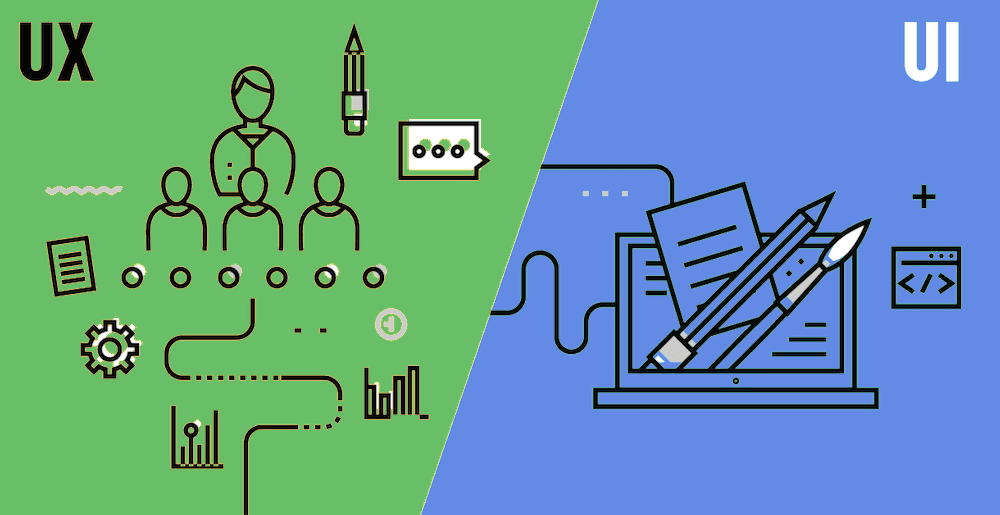To simplify it, a UX Designer is in charge of the overall outcome of the project. This means they need to be involved in many different places at once, ensuring the value to the user is never watered down or compromised and representing the best interests of the user’s experience.
On the other hand, the UI Designer is a more focused role, being in charge of only a specific area of the project, ensuring that the interface is visually appealing and can be interacted with in a successful way.
To me, the UX and the UI are the two aspects that literally define the success of your product. UX and UI are the two aspects that literally define the success of your product.
UX DESIGNER (USER EXPERIENCE DESIGNER)
UX designers are primarily concerned with how the product feels. A given design problem has no single right answer. UX designers explore many different approaches to solving a specific user problem. The broad responsibility of a UX designer is to ensure that the product logically flows from one step to the next. One way that a UX designer might do this is by conducting in-person user tests to observe one’s behavior. By identifying verbal and non-verbal stumbling blocks, they refine and iterate to create the “best” user experience. An example project is creating a delightful onboarding flow for a new user.
Many people think the job of UX is to lay out wireframes to specify where elements go, and do it in a way that the user won’t get confused while using your app.
Sure, that’s a part of it, but that’s not even close to the most important part. To understand the role of UX, you need to think about what defines the success of what you’re building.
When a user interacts with your product, and it delivers the value you promised them in a positive way, then you’ve built a successfully usable product.
But, going from idea to finished product is a long, drawn out process, and if no one is responsible for keeping the user’s experience in mind, then it will quickly get buried under piles of feature requests, egos, ideas, and added “fluff”.
It’s your UX Designer’s job to know everything there is to know about your users, and to keep their experience consistent throughout all phases of your project.
This means your UX Designer needs to be involved in every step of the process, from concept to execution to implementation.
The UX Designer’s responsibilities may include things like:
Competitor Analysis
Customer Analysis
Product Structure/Strategy
Content Development
Wireframing and Prototyping:
Wireframing
Prototyping
Testing/Iteration
Development Planning
Execution and Analytics
Coordination with UI Designer(s)
Coordination with Developer(s)
Tracking Goals and Integration
Analysis and Iteration
UI DESIGNER (USER INTERFACE DESIGNER)
Unlike UX designers who are concerned with the overall feel of the product, user interface designers are particular about how the product is laid out. They are in charge of designing each screen or page with which a user interacts and ensuring that the UI visually communicates the path that a UX designer has laid out. For example, a UI designer creating an analytics dashboard might front load the most important content at the top, or decide whether a slider or a control knob makes the most intuitive sense to adjust a graph. UI designers are also typically responsible for creating a cohesive style guide and ensuring that a consistent design language is applied across the product. Maintaining consistency in visual elements and defining the behavior such as how to display error or warning states fall under the purview of a UI designer.
Many people also think the job of a UI Designer is to just make wireframe mockups look visually appealing.
Once again, while this is technically correct, it’s not the most important part. It’s not only about the way the visuals look, but how they work, where they’re placed, and how easy it is to determine what can be interacted with.
For example, if I created the wireframe for an eCommerce store, I would probably specify where I wanted a price slider to be. On that wireframe, the price slider would be represented by a box that says “price slider”.
It’s the User Interface Designer’s job to take that box and turn it into an element that lets the user understand what it does and how it works, just by looking at it. That in itself is a huge task.
The UI Designer may also suggest a different placement for elements, or different types of elements to create a better interface. Maybe that price slider sucks, and they have a better solution, so they implement that instead, all while keeping the user’s experience in mind.
The UI Designer is building tools for our users to interact with in an enjoyable way.
Their responsibilities may include things like:
Customer Analysis
Design Research
Branding and Graphic Development
User Guides/Storyline
Responsiveness and Interactivity:
UI Prototyping
Interactivity and Animation
Adaptation to All Device Screen Sizes
Implementation with Developer
